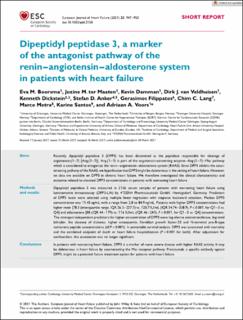| dc.description.abstract | Aims
Recently, dipeptidyl peptidase 3 (DPP3) has been discovered as the peptidase responsible for cleavage of angiotensin (1–7) [Ang (1–7)]. Ang (1–7) is part of the angiotensin-converting enzyme–Ang (1–7)–Mas pathway which is considered to antagonize the renin–angiotensin–aldosterone system (RAAS). Since DPP3 inhibits the counteracting pathway of the RAAS, we hypothesize that DPP3 might be deleterious in the setting of heart failure. However, no data are available on DPP3 in chronic heart failure. We therefore investigated the clinical characteristics and outcome related to elevated DPP3 concentrations in patients with worsening heart failure.
Methods and results
Dipeptidyl peptidase 3 was measured in 2156 serum samples of patients with worsening heart failure using luminometric immunoassay (DPP3-LIA) by 4TEEN4 Pharmaceuticals GmbH, Hennigsdorf, Germany. Predictors of DPP3 levels were selected using multiple linear regression with stepwise backward selection. Median DPP3 concentration was 11.45 ng/mL with a range from 2.8 to 84.9 ng/mL. Patients with higher DPP3 concentrations had higher renin [78.3 (interquartile range, IQR 26.3–227.7) vs. 120.7 IU/mL (IQR 34.74–338.9), P < 0.001, for Q1–3 vs. Q4] and aldosterone [88 (IQR 44–179) vs. 116 IU/mL (IQR 46–241), P < 0.001, for Q1–3 vs. Q4] concentrations. The strongest independent predictors for higher concentration of DPP3 were log-alanine aminotransferase, log-total bilirubin, the absence of diabetes, higher osteopontin, fibroblast growth factor-23 and N-terminal pro-B-type natriuretic peptide concentrations (all P < 0.001). In univariable survival analysis, DPP3 was associated with mortality and the combined endpoint of death or heart failure hospitalization (P < 0.001 for both). After adjustment for confounders, this association was no longer significant.
Conclusions
In patients with worsening heart failure, DPP3 is a marker of more severe disease with higher RAAS activity. It may be deleterious in heart failure by counteracting the Mas receptor pathway. Procizumab, a specific antibody against DPP3, might be a potential future treatment option for patients with heart failure. | en_US |

